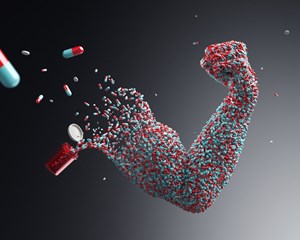Other estimates suggest even higher numbers. A paper published in 2011 examined the prevalence of "blood doping", a catch-all term for ways to increase the capacity of blood to ferry oxygen to muscles. The researchers analysed samples from more than 2,700 athletes and concluded that 14% were probably guilty (though the tests fell short of explicit proof). That average concealed wide variations. Some countries had prevalence rates as high as 48%, though the researchers diplomatically refused to name the alleged offenders.
其他估計(jì)數(shù)字甚至更高。2011年發(fā)表的一篇論文調(diào)查了“血液興奮劑”的流行情況。“血液興奮劑”是一個(gè)籠統(tǒng)的術(shù)語,指的是增加血液向肌肉輸送氧氣的能力。研究人員分析了2700多名運(yùn)動(dòng)員的樣本,得出的結(jié)論是14%的運(yùn)動(dòng)員可能有罪(盡管測(cè)試缺乏明確的證據(jù))。這個(gè)平均值掩蓋了很大的差異。一些國家的流行率高達(dá)48%,盡管研究人員委婉地拒絕說出被指控的罪犯的名字。
Another study, published in 2018, simply asked more than 2,000 athletes whether they were doping. The data were collected in 2011 at two big competitions—the World Championships in Athletics and the Pan-Arab Games. To encourage honest responses, the researchers used what is called the randomised-response technique. This guarantees individual answers will remain anonymous and untraceable. They concluded that 43.6% of the athletes surveyed had doped in the past year. Translated to Tokyo, that would imply around 4,800 drug-boosted competitors—roughly in line with Mr Chalmers' fears.
2018年發(fā)表的另一項(xiàng)研究只簡單詢問了2000多名運(yùn)動(dòng)員是否服用了興奮劑。這些數(shù)據(jù)收集于2011年兩大賽事——世界田徑錦標(biāo)賽和泛阿拉伯運(yùn)動(dòng)會(huì)。為了獲得真實(shí)的回答,研究人員使用了所謂的隨機(jī)反應(yīng)技術(shù),確保了個(gè)人的回答將保持匿名和不被追蹤。他們得出的結(jié)論是,有43.6%的受訪運(yùn)動(dòng)員在過去一年中服用過興奮劑。換作在東京奧運(yùn)會(huì)的話,這意味著大約有4800名運(yùn)動(dòng)員服用了興奮劑,該結(jié)論與查爾默斯先生的擔(dān)憂大致相符。

But all these estimates are just that: estimates. "My gut feeling, from having worked with many Olympic-level athletes, is that the randomised-response numbers are too high," says Yorck Olaf Schumacher, who helped develop the Athlete Biological Passport (ABP), a widely used anti-doping test that tracks blood readings, looking for suspicious changes. Some athletes may not have understood the question properly, he says, or may have confused legitimate dietary supplements with doping.
但所有這些估計(jì)都只是估計(jì)。“我和許多奧運(yùn)會(huì)水平的運(yùn)動(dòng)員一起工作過,我的直覺是隨機(jī)反應(yīng)的數(shù)字太高了,”幫助開發(fā)了運(yùn)動(dòng)員生物護(hù)照(ABP)的約克·奧拉夫·舒馬赫說。運(yùn)動(dòng)員生物護(hù)照是一種被廣泛使用的反興奮劑測(cè)試,可以跟蹤血液讀數(shù),尋找可疑的變化。他說,一些運(yùn)動(dòng)員可能沒有正確理解這個(gè)問題,或者可能把合法的膳食補(bǔ)充劑和興奮劑混淆了。
Athletes dope because drugs offer big advantages—potentially so big that undoped rivals have no hope of matching them. WADA, the rules of which bind many sports, maintains a list of hundreds of banned substances. They range from obscure chemicals with names like IGF-1 LR3 and AOD-9604 to insulin (to boost muscle size), amphetamines (for their stimulating effects) and even diuretics (used to mask the presence of other drugs). The clandestine nature of doping means that, for most drugs, there is little hard evidence for their effect on performance. Athletes are forced to rely instead on locker-room rumours and "street knowledge", says Chris Cooper, a sports scientist at the University of Essex, much of which will probably be exaggerated. But for some of the best-known drugs, science—and history—can give a sense of the advantages on offer.
運(yùn)動(dòng)員服用興奮劑是因?yàn)樗幬锾峁┝司薮蟮膬?yōu)勢(shì)——潛在的優(yōu)勢(shì)是如此之大,以至于未服用興奮劑的競(jìng)爭(zhēng)對(duì)手無法匹敵。世界反興奮劑組織(WADA)制定了一份包含數(shù)百種違禁物質(zhì)的清單,該清單約束了許多運(yùn)動(dòng)項(xiàng)目。它們種類繁多,從名稱模糊的化學(xué)物質(zhì),如IGF-1 LR3和AOD-9604,到胰島素(增加肌肉體積),安非他命(具備刺激作用),甚至利尿劑(用于掩蓋其他藥物的存在)。興奮劑的隱秘性質(zhì)意味著,對(duì)于大多數(shù)藥物來說,幾乎沒有確鑿的證據(jù)能夠表明它們對(duì)成績有影響。埃塞克斯大學(xué)的體育科學(xué)家克里斯·庫珀表示,運(yùn)動(dòng)員們被迫依賴于更衣室謠言和“街頭知識(shí)”,其中很多可能會(huì)被夸大。但是對(duì)于一些最著名的藥物來說,科學(xué)和歷史可以讓我們知道它所提供的優(yōu)勢(shì)。
譯文由可可原創(chuàng),僅供學(xué)習(xí)交流使用,未經(jīng)許可請(qǐng)勿轉(zhuǎn)載。











